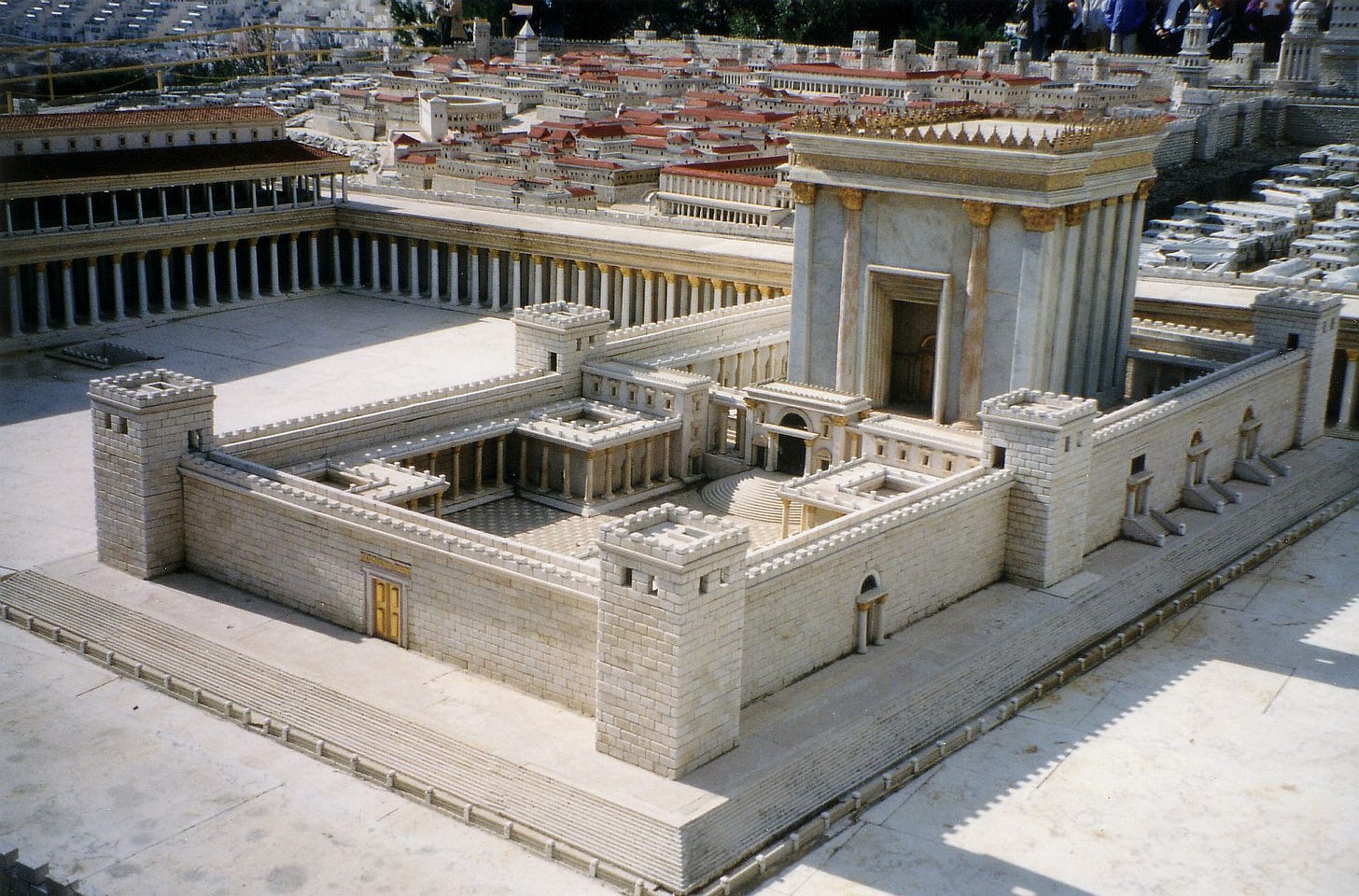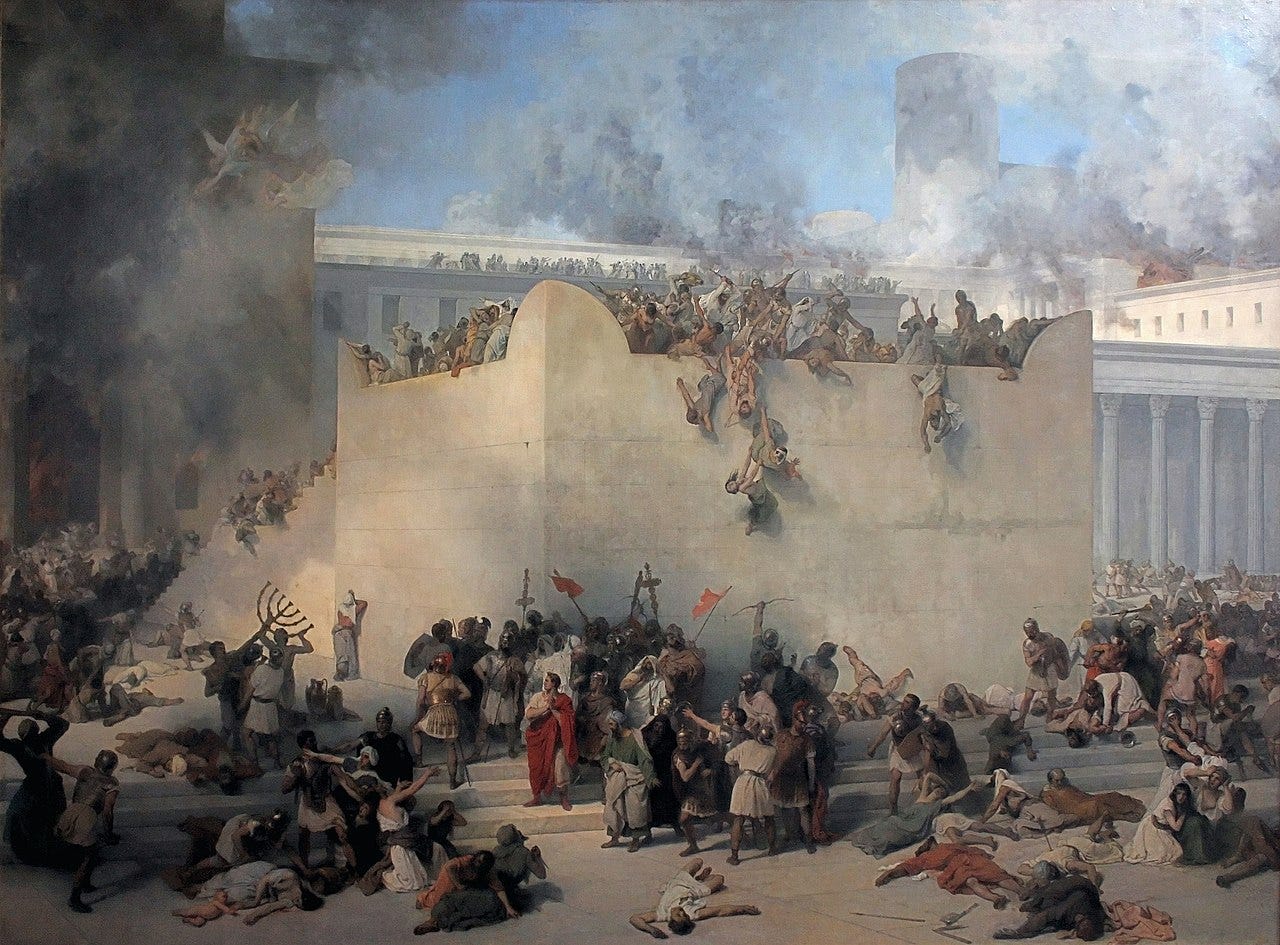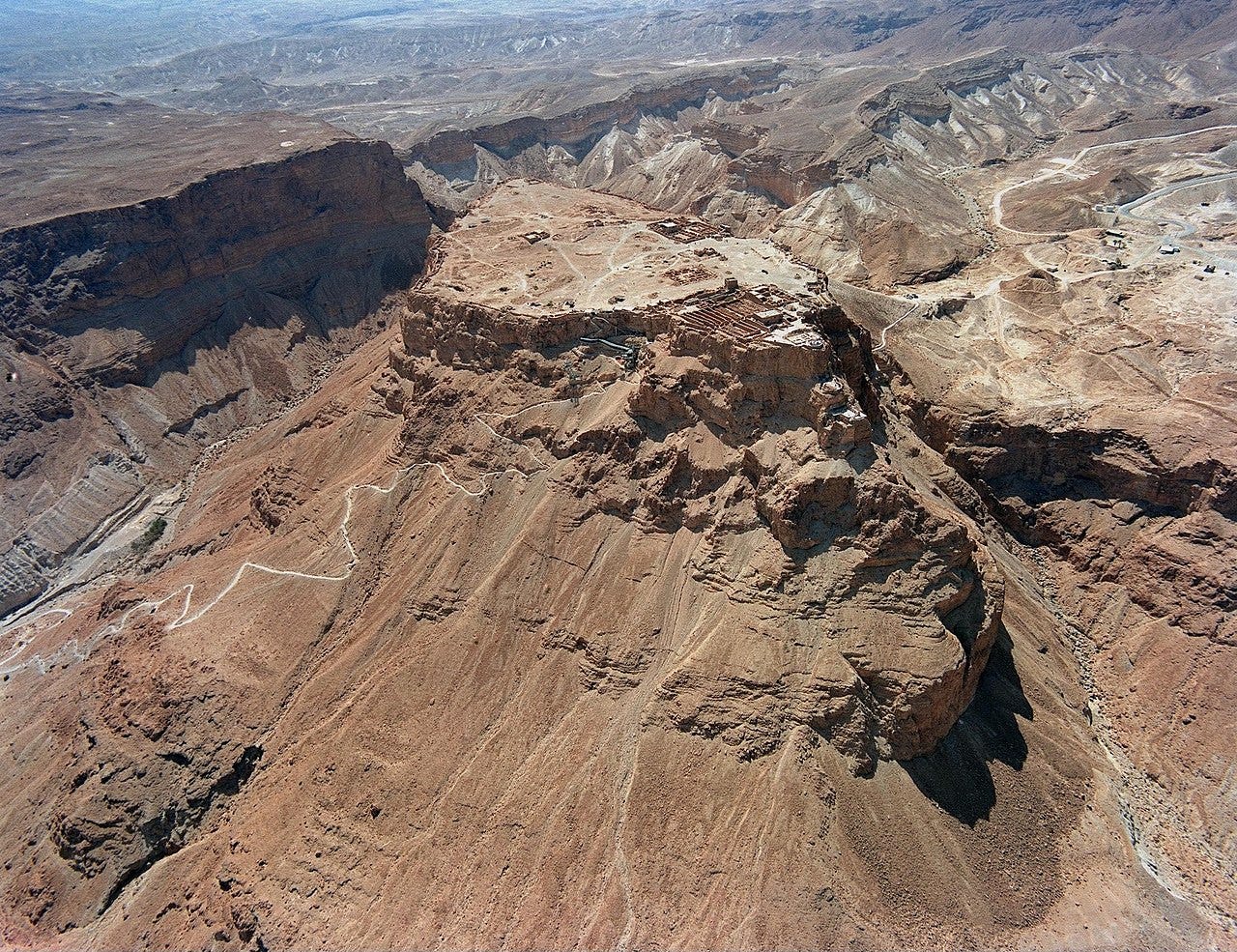The Early Roman Empire and the Principate: The Jewish Revolt
Jewish Zealots, Roman siege-works, and horrific suffering
Continuing my alternating posts on historiography and the early Roman Empire, we go back to the Flavian dynasty this week, and one of the most notorious events of the late 1st century.
Update - well, it seems that, in my tiredness, I didn’t finish putting in the citations and marking them as footnotes. Apologies for the formatting errors. They have now been fixed.
Zealous rebels -
The Flavian Dynasty (Vespasian and his sons) owed part of their prestige in Rome to their success in putting down one of the more infamous revolts in history. Judea was generally something of a backwater province as far as the Romans were concerned, one that was often more trouble than it was worth. The Jews in Israel had originally invited the Romans in to help them kick out the Hellenistic kings that had succeeded Alexander the Great, but as Rome consolidated its hold on the entire Mediterranean, Judea was incorporated as a rump province of Syria with an official governor, in addition to having a puppet Jewish monarch.
The Romans usually tried, as elsewhere, to rule the Jews with a light hand and religious tolerance. In fact, part of the crucifixion story of Jesus can be interpreted as the Romans trying to keep the Jewish leaders happy, as much as it was also about the fear of a revolt under the King from Nazareth against Caesar. But ancient Judaism was a unique religious and social force, one that many pagan kingdoms had a hard time understanding, or relating to. Judaism was as much an ethnic and cultural identity as it was a religious one, and the unique relationship the Jews believed they had with their God meant that they tended to see themselves marked out as a special people. For Jews, bringing back the ancient Kingdom of David was equally political and religious. To the Romans also, the idea of having just one god, and not worshiping any other, was bizarre. In time, the Romans would occasionally call both Jews and Christians “atheists,” as people who denied all the classical gods of the Pantheon.

While the Jews had a king, and the hierarchy of the temple priestly class, the ability of this elite to enforce their religious authority was often quite limited in the face of rabid factionalism. There were as many Jewish sects and groups as you could shake a stick at, and they often had some radical ideas (insert your obligatory reference to Monty Python’s “Judean People’s Front” vs “Peoples Front of Judea” joke here). At the most extreme end, were nationalistic groups that believed it was an eternal crime to have any outside rulers in Israel, and that the whole land would be unclean until every Roman was gone (or dead). These Zealots often protested or even rioted against Roman occupation. In 66 AD things boiled over.
After an initial outrage involving foreigners performing sacrifices outside of a synagogue, and in response to tax protests, the Roman Procurator Gessius Florus entered the Jewish temple in Jerusalem and forcibly expropriated seventeen talents of silver ostensibly as back-taxes1. Ancient temples were often used as unofficial treasuries of sorts (the Athenians had done the same with the Parthenon), but allowing unclean pagans into their Holy of Holies was a terrible blasphemy to the Jews. The Zealots rose in revolt, initially fighting chiefly against the priestly class in Jerusalem. Factional violence spilled over throughout Judea and Syria, as Jewish zealots attacked both the priestly class and the Romans, and the Romans retaliated by terrorizing the populace and sending Jewish prisoners en masse to the slave galleys2. Finally, the Zealots seized control of much of the country, destroyed an entire legion sent to put them down, and began digging in in Jerusalem.
Nero sent Vespasian (this was shortly before he would become emperor) and his son Titus to Judea the following year (67 AD) with several legions, and father and son set to work putting down the rebellion. One of the Jewish commanders in Galilee who surrendered to the Romans became a slave of Vespasian’s, before later being freed, taking the family name of Flavius (along with the name of Vespasian’s son Titus), and becoming the famous Jewish-Roman historian we know as Titus Flavius Josephus. Josephus’ famous account of the Jewish Revolt and Roman destruction of Jerusalem remains an important source for Roman military history, late Second Temple Judaism, and even contains some of the earliest non-Biblical references to the Christian Church.
The Siege of Jerusalem (70 AD) -
The ensuing siege of Jerusalem had long-term consequences for Jewish history. Vespasian left Judea in 69 AD to go back to Italy and win the Year of the Four Emperors, leaving Titus to prosecute the siege in typically methodical and ruthless Roman fashion the following year. It is not commonly appreciated by laymen just how much the Roman army of the early imperial period was built for siege-work. Outside of civil wars, large open-field battles were comparatively rare, and one of the most important aims of Roman grand strategy3 at this time was maintaining Rome’s control over the political centers of power that governed the provinces. For the better part of two centuries, going back to the late Republic, Roman tactical and logistical superiority inevitably drove opponents to resort to hiding behind walls. Numerically, most of Julius’ Caesar’s actions in Gaul were sieges of Celtic hill-forts, and much of his campaign against Pompey in Greece featured fortifications and attempts to extend trenches around opposing positions4. Roman legionaries had an almost unprecedented level of physical armor, and the famous testudo formation was used not on an open battlefield, but to approach fortifications under fire, while Roman artillery pieces (featuring many types built to standard sizes and weights) battered walls and suppressed defenders. And of course, underneath this strategic and operational imperative lay centuries of Roman expertise as possibly the best military engineers in history.


Titus went to work. The Romans built huge earthen ramps and towers, from which artillery pieces could suppress the defenses, while battering rams were used to crack the walls themselves. Jerusalem had three sets of walls enclosing different quarters of the city, and the Romans had to grind down each zone in turn. Jewish sorties repeatedly caused heavy casualties and damaged the siege works, and foraging parties left the city daily to scavenge for food. In return, the Romans tortured and executed anyone they caught outside the walls, and Josephus claims that five-hundred Jews were crucified daily, until the Roman soldiers began to run out of room (and wood) for the crosses.5 Eventually, Titus decided that he had to completely isolate the defenders, and so he built walls of circumvallation around the entire city. The legions, driven to a competitive show of eagerness, built the entire five miles of fortifications in three days.6

As ruthlessly effective as the Roman siege was, the Jewish Zealots still managed to be their own worst enemy. Factional infighting continually broke out both before and during the siege, and led to the deliberate burning of most of the city’s foodstuffs, “which would have been sufficient for a siege of many years.”7 Fighting continued during the siege, and life in the city turned anarchic, as roving gangs broke into houses taking food at will from terrorized civilians who hurriedly prepared and ate their meals half-cooked before the smell of baking aroused the thugs. Jerusalem had been crowded at the start of the siege, as tens of thousands of pilgrims who had arrived to celebrate Passover had found themselves trapped. Now, the civilian population was reduced to eating leather and animal dung. In an utterly gruesome passage, Josephus recounts a wealthy woman driven mad by robbers who repeatedly stole her food, until she finally killed and roasted her infant son, eating part and offering the rest to the horrified robbers, who turned and fled.8

Finally, after over five months, the Jerusalem fell. Most of the city was burned or destroyed, including the Temple Mount. Josephus claims the initial fire which destroyed most of the temple was either an accident, or started by the Jews (all that remains today are the remnants of the famous Western “Wailing Wall” in Jerusalem). Titus gave orders to leave three towers standing as a memory of the fortifications and of the skill and bravery required to capture them, but the rest of the city was leveled:
“but for all the rest of the wall, it was so thoroughly laid even with the ground by those that dug it up to the foundation, that there was left nothing to make those that came thither believe it had ever been inhabited. This was the end which Jerusalem came to by the madness of those that were for innovations; a city otherwise of great magnificence, and of mighty fame among all mankind.9
Josephus records 97,000 captives taken, and over one-million dead, which he attempts to justify by extrapolating an upper bound for the size of the city’s population based on earlier sacrificial records during the Passover season.10 I have seen claims that Tacitus records closer to half a million, though I don’t have an immediate citation. Modern historians offer their inevitable lower estimates.
The destruction of the Temple, rebuilt in the Old Testament after the end of the Babylonian Captivity, was marked by Christians as fulfilling Christ’s prophecy about the Temple’s destruction in the Gospel of Mark. While Jews had already dispersed around the Mediterranean, the Diaspora would only accelerate after the first Roman-Jewish War. As bad as the siege of Jerusalem had proven, the Romans and Jews would have to do it all over again barely sixty years later under the emperor Hadrian and the Jewish pseudo-Messiah Simon Bar Kokhba.

Postscript at Masada
With the fall of Jerusalem, most organized resistance ended quickly. But one last group of a few hundred Zealots held out against the Romans by retreating into the desert mountains and a high fortress up on a ridge at Masada.11 Masada was thought to be virtually impregnable, with narrow paths dominated by the walls of the complex all the way up to a steep entrance before the main gate, also strengthened. The rebels had food and water to last several years, and the Romans could have contented themselves with settling down for a long siege with a skeleton garrison; they weren’t going anywhere. But the Roman commander, Lucius Flavius Silva, wanted to prove a point; nobody defied Rome without consequence, and there was nowhere on Earth that Rome couldn’t go to settle a score. Silva circumvallated the entire mountain with exterior walls, and then had his men start work on a gigantic siege ramp. Over several months, his troops slowly built the ramp up from a rocky promontory, widening the base as they went. The ramp eventually rose almost three-hundred feet high, containing tens of thousands of tons of rock and rubble. All this just to get at less than a thousand fanatics who were already dead men walking. When the Romans finally got up to the level of the fortress, burning and then breaking the last walls of the defenders, they found almost the entire garrison dead; only a few women and children survived to tell the soldiers how the Zealots had killed each other to avoid slavery. The remains of the siege ramp are still there today, testifying to the ability of a great empire to literally remake the face of the earth.

Josephus, “Wars of the Jews,” translated by William Whiston, Accessed via Project Gutenberg. Bk II. 14.6
If Roman Grand Strategy even existed, which is actually a pretty interesting historiographical debate I might write about at some point.
Reading about Caesar’s Civil War campaigns and the use of fortifications is oddly reminiscent of the later campaigns in the American Civil War. Echoes of Petersburg.


